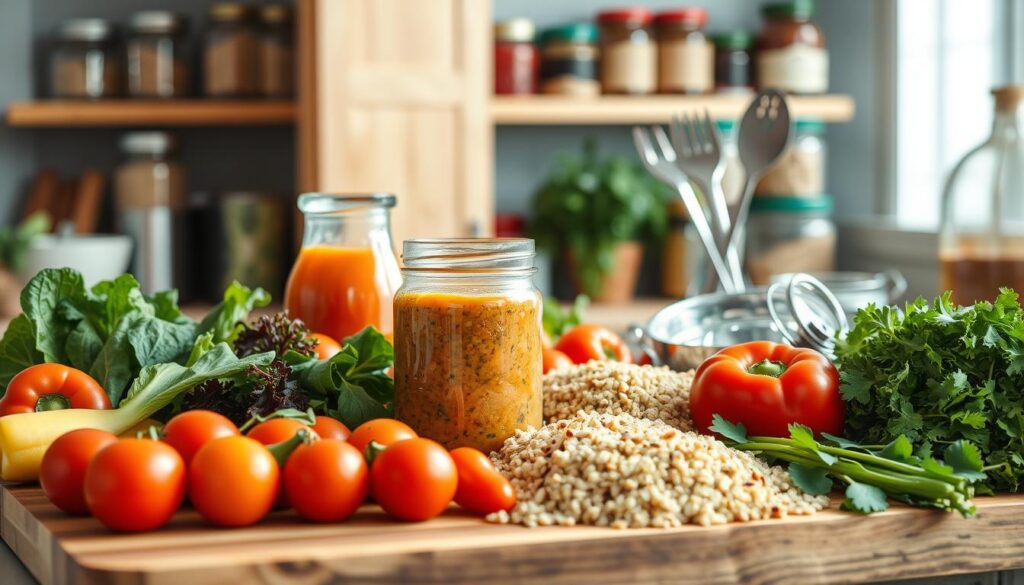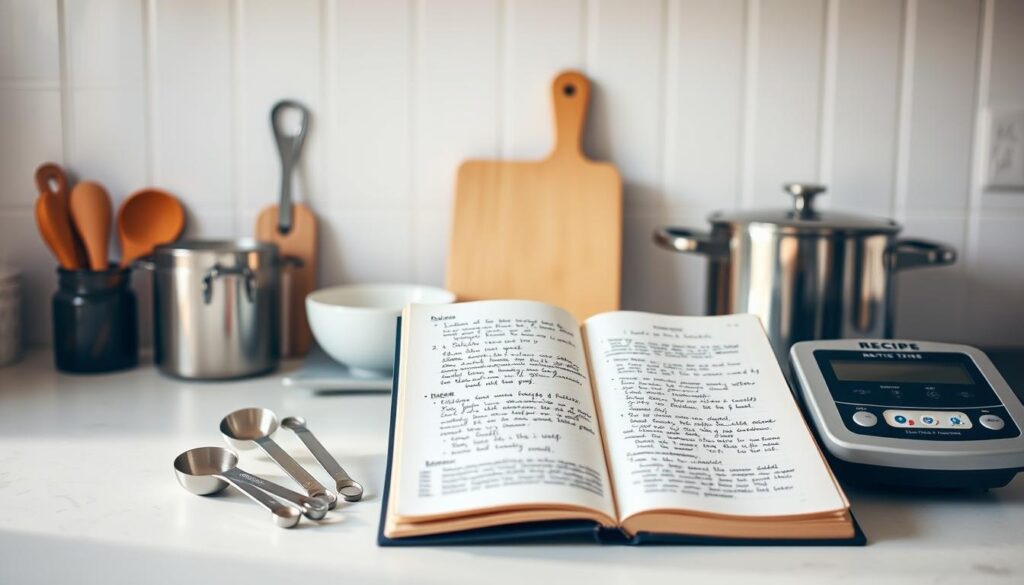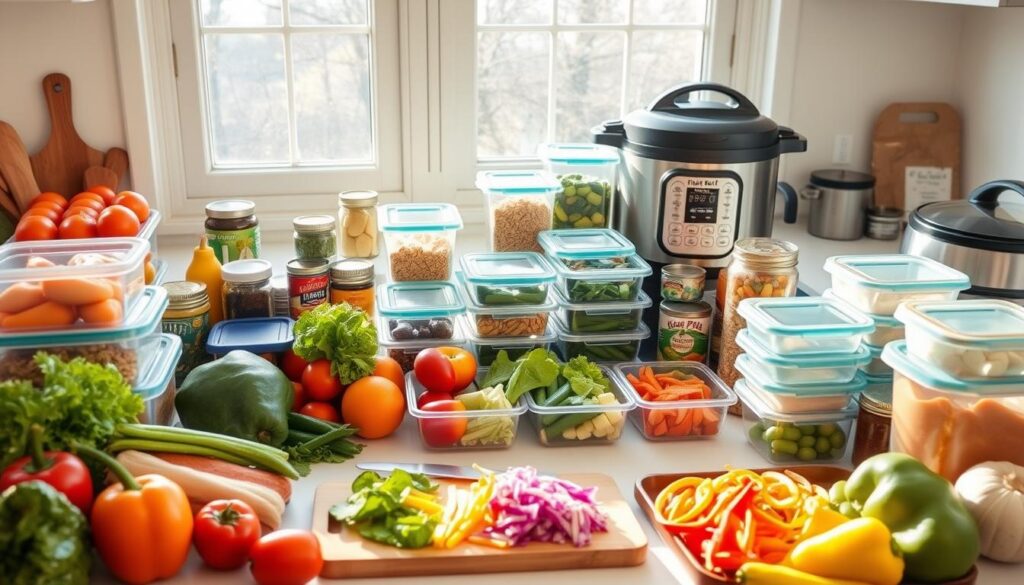Welcome to the world of meal prep on a budget! It’s easy to cook a week’s worth of food for just $40. This approach saves money, promotes healthy eating, and cuts down on food waste. You can make tasty, affordable meals that suit your lifestyle.
Meal prep is a big help for saving time and money. It lets you plan and prepare meals ahead of time. This way, you can enjoy healthy, affordable dishes. Meal prep is ideal for college students, busy professionals, or families with limited budgets.
Adding meal prep to your daily routine means eating healthy without spending a lot. With some planning and creativity, you can make delicious, budget-friendly meals. Meal prep is a smart choice for saving time and money.
Understanding the Basics of Budget-Friendly Meal Prep
Before you start with meal prep, it’s key to know the basics. This means having a good plan for meal planning. It’s about making a schedule and following it. A good plan can save you time and money, helping you stay on budget.
Grocery shopping is a big part of meal prep. By planning meals ahead, you can make a list of what you need. This stops you from buying things on impulse. It also helps you avoid wasting food and stay within your budget. Plus, knowing some cooking tips can really improve your meals.
Having the right kitchen tools can also help a lot. Things like a slow cooker, rice cooker, or instant pot are great. They make cooking meals like soups or stir-fries easier and faster.
Essential Ingredients
- Rice
- Beans
- Oats
These ingredients are cheap, flexible, and can be used in many dishes. Having them in your pantry is a good start for meal prep.
Smart Shopping Strategies for $40 Weekly Groceries
To get Affordable Groceries on a $40 budget, smart Budget Shopping is key. Plan your meals with seasonal produce, which is cheaper and fresher. This way, you can make tasty, healthy meals without breaking the bank.
Consider buying in bulk, using coupons, and grabbing items on sale. Cashback apps can also help you earn rewards. Plus, skip processed foods for whole foods, which are cheaper and better for you.
- Make a list of the items you need and stick to it
- Compare prices between different stores and brands
- Buy in bulk and plan your meals around the items you have
- Use coupons and cashback apps to earn rewards
Follow these tips and watch your shopping habits. You’ll find a Meal Planning strategy that fits your budget. Enjoy Affordable Groceries and master Budget Shopping.
Planning Your Weekly Menu
Planning your weekly menu is key to meal prep success. It saves time, money, and ensures healthy, tasty meals. Start by thinking about your diet, lifestyle, and schedule. Do you have a busy week or time for elaborate meals?
For breakfast recipes, try oatmeal with fruit or scrambled eggs with veggies. These breakfast recipes are affordable and full of nutrients. They keep you energized in the morning.
For lunch ideas, pick easy-to-pack meals like soup, salad, or whole grain sandwiches. These lunch ideas are great for quick meals on busy days.
For dinner options, think about stir-fries, skillet meals, or slow cooker recipes. They use various ingredients and stretch your budget. Some dinner options include:
- Stir-fry with vegetables and lean protein
- Skillet meal with whole grains and legumes
- Slow cooker recipe with beans and vegetables
Here’s a sample weekly menu plan:
| Day | Breakfast | Lunch | Dinner |
|---|---|---|---|
| Monday | Oatmeal with fruit | Whole grain sandwich | Stir-fry with vegetables and lean protein |
| Tuesday | Scrambled eggs with veggies | Soup and salad | Skillet meal with whole grains and legumes |
| Wednesday | Yogurt parfait | Whole grain wrap | Slow cooker recipe with beans and vegetables |
Budget Friendly Meals That Actually Taste Good
Healthy eating doesn’t have to be expensive. With a bit of creativity, you can make tasty and affordable meals. Options range from hearty soups to flavorful stir-fries.
Proper food storage is key to saving money. It keeps meals fresh longer and cuts down on waste. This saves money and helps the environment. Use airtight containers, label and date meals, and store them in a cool, dry place.
Here are some budget-friendly meal ideas for healthy eating:
- Grilled chicken or vegetable skewers with roasted potatoes and steamed broccoli
- Lentil soup with whole grain bread and a green salad
- Stir-fry with brown rice, mixed vegetables, and your choice of protein (chicken, beef, or tofu)

There are many ways to make healthy eating affordable. Buy in bulk, shop for seasonal produce, and plan meals ahead. By following these tips and being mindful of food storage, you can enjoy delicious and affordable meals.
Maximizing Protein on a Tight Budget
Protein is key in any meal, but it can be hard to get enough without spending too much. Luckily, you can boost your protein without breaking the bank. Look into affordable protein sources like beans, lentils, and tofu. They’re cheap, versatile, and full of nutrients.
Don’t think you have to choose between quality and price when it comes to meat options. Buy chicken, ground beef, or fish in bulk. Use them in many dishes. Also, try plant-based diet choices like tempeh, seitan, or veggie burgers. Find protein sources that match your budget and lifestyle.
- Incorporate plant-based diet options like beans, lentils, and tofu into your meals
- Purchase meat options like chicken, ground beef, or fish in bulk
- Get creative with protein sources like tempeh, seitan, or veggie burgers
Follow these tips to make a balanced, affordable diet. Always choose whole, unprocessed foods. Be creative with your meals to get more protein.
Batch Cooking Techniques That Save Time and Money
Batch cooking is a big help for meal prep. It saves time, cuts down on waste, and lowers your grocery bill. Cooking big batches lets you make many meals, like soups and stir-fries. You can also tailor them to fit your diet and taste.
Good time management is crucial for batch cooking. It helps you plan and prepare meals ahead of time.
Planning well for batch cooking can maximize your meal prep efforts. Cook proteins like chicken or beans in bulk. Roast big batches of veggies, like broccoli or sweet potatoes. Also, make lots of grains, like rice or quinoa, for meal bases.
By adding batch cooking to your meal prep, you simplify cooking. You can whip up healthy, tasty meals without hassle.
To start batch cooking, make a big batch of something like cooked chicken or roasted veggies. Then, use it for different meals all week. Using a slow cooker or instant pot makes batch cooking even simpler.
By using these time management tips and batch cooking in your meal prep, you save time and stress. You’ll enjoy healthy, homemade meals all week.
Storage Solutions for Weekly Meal Prep
Proper Food Storage is key to keeping your meals safe and fresh. Having the right containers makes a big difference in meal prep. A good set of Meal Prep Containers keeps you organized and your meals fresh longer.
A smart storage plan also makes your freezer work better. Freezer Meals like soups and casseroles are great for busy days. Just label and date your containers to track what’s in the freezer and how long it’s been there.
- Using airtight containers to prevent moisture and other flavors from affecting your meals
- Labeling and dating containers so you can easily keep track of what you have and how long it has been stored
- Storing meals in the refrigerator at a temperature of 40°F (4°C) or below to prevent bacterial growth
Follow these tips and use the right storage to keep your meals fresh and safe. This way, you’ll get the most out of your meal prep.
Preventing Meal Prep Burnout
To avoid Meal Prep Burnout, keep your meals interesting and varied. Try new recipes and add different spices and seasonings. This will make your meals flavorful and keep your taste buds excited.
Using various Cooking Tips and techniques can also help. Try one-pot wonders, sheet pan meals, or slow cooker recipes. These methods save time and effort, making meal prep fun and easy.
Here are some tips to help you prevent Meal Prep Burnout:
- Try new recipes and ingredients to keep your meals interesting
- Use different spices and seasonings to add flavor to your meals
- Incorporate various cooking techniques, such as one-pot wonders or slow cooker recipes
- Make sure to include a variety of Food Variety in your meal prep to keep your diet balanced and exciting
By following these tips, you can prevent Meal Prep Burnout and keep your meals exciting and delicious. Always try to keep your meals interesting and varied. Don’t be afraid to try new things.

Seasonal Shopping for Maximum Savings
Shopping for groceries in season is a smart way to save money. It also makes sure your meals are fresh and tasty. By using Budget Shopping tips in your Meal Planning, you can make tasty, affordable meals all year.
In spring and summer, look for cheap produce like berries, leafy greens, and stone fruits. These are great for salads, smoothies, grilled meats, and roasted veggies. For instance, you can whip up a summer salad with mixed greens, berries, and citrus vinaigrette. Or, grill peaches and serve them with yogurt and granola.
In fall and winter, focus on root veggies, citrus fruits, and hearty grains. These are perfect for warm soups, stews, and casseroles. Try making butternut squash soup, roasting Brussels sprouts with citrus and garlic, or cooking lentil stew with crusty bread.
- Buy in bulk and plan meals around what’s in season
- Shop at local farmers’ markets or join a CSA program
- Use herbs and spices for flavor instead of expensive sauces and condiments
By following these tips and using Seasonal Produce in your Meal Planning, you can save on groceries. You’ll also make delicious, healthy meals all year. Always shop smart and plan meals well to get the best from your Budget Shopping strategy.
Scaling Recipes for Different Family Sizes
When planning meals, the number of people matters a lot. Whether you’re alone or have a big family, scaling recipes helps save money and food. You need to change the amount of ingredients, cooking time, and how you store food to keep meals fresh and safe.
Being flexible with family meals is key. You might need to make more or less food depending on the event. Having recipes that can be easily adjusted is very helpful. For instance, a simple pasta dish can be made bigger for a family event or smaller for a single person’s lunch.

- Start with a base recipe and adjust ingredient quantities based on the number of people you’re serving
- Consider the cooking time and adjust as needed to prevent overcooking or undercooking
- Use storage solutions like containers and freezer bags to keep meals fresh and organized
Learning to scale recipes and plan meals well lets you make tasty and budget-friendly meals for your family.
Common Budget Meal Prep Mistakes to Avoid
Meal prep can save you time, money, and stress. A big Meal Prep Mistake is not planning meals ahead. This can lead to expensive takeout or dining out. To avoid this, plan your meals for the week. Think about your schedule, what you like to eat, and what ingredients you can find.
Another mistake is buying things you already have. Before shopping, check what you have at home. Plan meals using what you already have. This saves money and reduces waste, keeping food fresh longer.
Here are some common mistakes to watch out for:
- Not labeling or dating your prepped meals, making it difficult to keep track of what you have and how long it’s been stored
- Not using proper Food Safety guidelines when handling and storing food, which can lead to contamination and illness
- Not considering your dietary needs and preferences when planning meals, resulting in prepped meals that are unappetizing or unhealthy
By knowing these Meal Prep Mistakes and avoiding them, your meal prep can be a success. Always focus on Food Safety and Budget Cooking to make the most of your meal prep.
Conclusion: Making Budget Meal Prep a Sustainable Lifestyle
Learning to budget meal prep is more than a quick fix. It’s a lasting choice that changes how you see food, money, and health. This guide shows you how to make budget-friendly meal prep a daily habit.
Success comes from planning, staying organized, and trying new things. Create tasty, healthy meals without breaking the bank. Saving money and cutting down on waste will keep you going. With a bit of creativity and dedication, budget meal prep can enrich your life.
The path to a sustainable lifestyle is about making progress, not being perfect. Begin with small steps, celebrate your wins, and tweak your methods as you go. By making budget meal prep a regular part of your life, you’ll save money and take care of your body and mind. This sets you up for a healthier, happier future.
FAQ
What are the essential kitchen equipment I already have for budget-friendly meal prep?
You can use a slow cooker, rice cooker, or instant pot for many affordable meals.
What are some basic ingredients that form the foundation of budget-friendly meal prep?
Rice, beans, oats, frozen veggies, and eggs are great for saving money.
How can I save money when grocery shopping for my weekly meal prep?
Buy in bulk, use coupons, shop for seasonal produce, and avoid processed foods to save money.
What are some budget-friendly breakfast ideas that cost less than $1 per serving?
Try oatmeal with fruit, scrambled eggs with veggies, or yogurt with granola for under $1.
What are some lunch options that travel well for budget-friendly meal prep?
Soup, salad, and whole grain sandwiches are great for on-the-go meals.
How can I incorporate affordable protein sources into my budget-friendly meal prep?
Use beans, lentils, tofu, chicken, ground beef, or fish for affordable protein.
What are some batch cooking techniques that can save me time and money?
Cooking proteins in bulk, roasting veggies, and making big batches of grains save time and money.
What are some food storage solutions to keep my weekly meal prep fresh?
Use the right containers, freeze meals, and follow food safety to keep meals fresh and safe.
How can I avoid meal prep burnout while staying on a budget?
Mix up recipes, try new techniques, and keep meals interesting to avoid burnout.
How can I take advantage of seasonal shopping to maximize my savings?
Buy in-season produce like berries in spring and root veggies in fall to save money.




Enjoyed reading this, very good stuff, appreciate it.